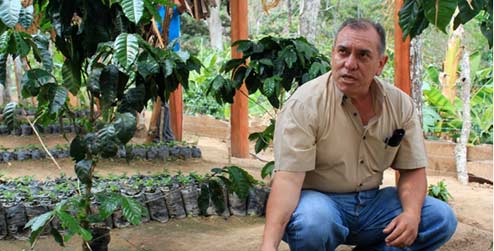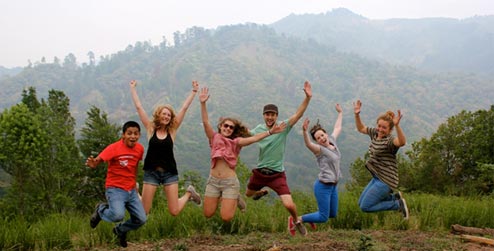Photo: by Dani Mansfield
La Laguna is situated 1080 metres up in the pine forests of northern Dipilto. From Dipilto Nuevo, it takes 30 minutes by truck, making it the most off-the-beaten-track coffee farm in Dipilto. The farm, all 80 hectares of it, sprawls up the mountain side, next to a lagoon, with its bright, colorful flowers, and an abundance of fish. Due to its secluded location, Pedro, the farm’s owner, wanted to create an ‘’adventure’’ farm, and he’s done just that!
Trek or horse ride through the steep-sided valleys, along the meandering cascades. Try your hand at milking a cow; fish in the lagoon, and cook your catch on the barbecue; or just relax among the fruit trees and the chirping birds, next to the pool, taking in the breath-taking flora & fauna.
You certainly will not get bored, at La Laguna!
How does it sound? Absolutely fantastic? Like a big ball of adventure? We hope it does. Because this is just onns of a coffee farm we have been helping to promote in Dipilto as part of our project to bring tourism there. Tourism is not always the most conventional sounding vehicle towards empowerment, but Dipilto is certainly an exception, for a number of reasons.
Dipilto’s economy relies on Coffee. The plant enjoys a temperate climate in amongst the shaded pine and tropical forests in the mountainous terrain of northern Nicaragua, making Dipilto a coffee hotspot. In fact, coffee makes up 14.1% of Nicaragua’s exports. Difficulties arise, however, from such an over reliance on a single commodity. Evidence of this came between 1999 – 2003 when an influx of cheap, south-east Asian coffee poured into the global market, undercutting the country’s chief export, and the 400,000 people who rely on coffee for an income in Nicaragua. Farms were scaled down, some went bust, and big protests erupted. Disheartened, degraded, and destitute, many of the farmers still live in the tin shacks along the Pan-American Highway today, begging for spare coins. A bleak reminder to the people of what an over reliance on coffee can do.
For the coffee farmers o f Dipilto, there are even more ominous hurdles to a fruitful harvest than the global market. The plants are being infested by ‘leaf rust’, a disease which can lower the plant’s yield or kill it entirely. Spreading from Honduras, it has crept south, to the dismay of the farmers: ‘it has been bad this year [due to] illness and the weather’ explained Roberto, the owner of Dalia farm. Meykell, a national volunteer, who has worked on coffee farms from a young age, confirmed the problems that farmers face, telling us that there has been ‘80% less coffee due to illness’. The farmers grow four types of coffee, only one, Caturra, is resistant to the ‘leaf rust’, but it produces coffee of a lesser quality. The farmer’s are thus stuck in a balancing act, to grow coffee of a lesser quality or chance ‘leaf rust’. Montesino, the owner of El Cairo farm, is attempting to develop resistant plants which he hopes to sell to other farmers, but this is still in the pipeline. And in many ways, the future of Nicaragua and Dipilto’s coffee, lies outside the border of Latin America’s second-poorest country, as Dr Schilling, executive director of World Coffee Research, explains: “wild and extreme climate events like this will continue and cause more problems as time goes on. We simply must invest in research to provide solutions to farmers while governments and the UN try to fix the global climate crisis.”
The changing climate is inextricably linked to the prevalence of ‘leaf rust’, and to mitigate against the hotter climate, the coffee plants are being planted in the cooler, higher altitudes. The mountains, however, only go so high.

Photo: by Dani Mansfield
The farmers belong to the cooperative FENACOOP, our partner-organisation. By promoting the natural beauty of Dipilto and the abundance of activities, the farmers can diversify their sources of income, giving them more security in the long-term. Bringing tourism to the coffee farms, will, we hope, cause a ripple effect, bringing work and opportunities to an area that has high poverty levels, and a lack of work. To do this, we have created a tourist leaflet, displaying the six farms we have worked with, a more in-depth brochure with details of accommodation restaurants and local artisanal activities, we have presented recommendations to the farmers on how they can make each farm more tourist-friendly, and the creation of a video, which international volunteer Danni has completed after many hours of graft and determination. Only a Dane could have such a work ethic! In many ways, the tasks we have carried out in Dipilto are a small part of a continuous project to bring tourism to Dipilto. The hope is that future ICS volunteers can carry the torch forward, and Dipilto, one day, will appear in the ever illustrious Lonely Planet, being graced with warm sentiment. For the group, the tourist project was a particular favourite. It gave us the independence to utilise our creativity in different areas, whilst having set objectives to adhere to. It also allowed our national volunteers, all of which are residents of Dipilto, to promote their town, and help paint its picture in bright patchwork colours.
And when all was completed on Friday, there was a lingering sadness among the group. We had developed a particular soft spot for Dipilto. With the picturesque setting among the mountains, with the friendly, relaxed inhabitants, and with the Alcadia [the town hall] who have been a tremendous help in providing the resources we needed to carry out the objectives which were set. We only hope that the next group will be as enchanted by Dipilto as we have been.





Comments
Impressive place, will
Impressive place, will certainly bear it in mind as a future holiday destination in eco tourism and spread the word amongst my friends.
Thank you Progressio Nicaragua for all your good work in Nicaragua!!